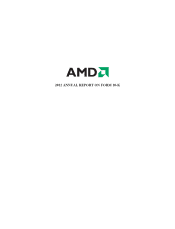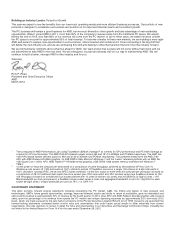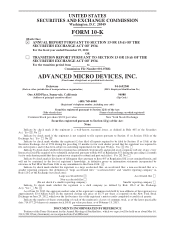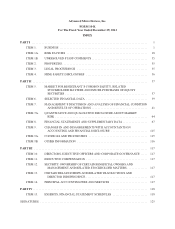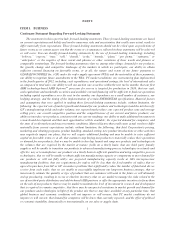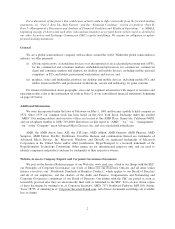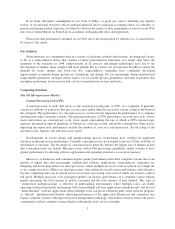AMD 2012 Annual Report Download - page 2
Download and view the complete annual report
Please find page 2 of the 2012 AMD annual report below. You can navigate through the pages in the report by either clicking on the pages listed below, or by using the keyword search tool below to find specific information within the annual report.
To Our Stockholders:
During 2012, a fundamental shift occurred that is re-defining the landscape of our industry and
providing new growth opportunities for AMD. Despite annual revenue declining 17% from the
prior year, we faced the macro environment challenges head-on by taking decisive actions to
position AMD for long-term success. Although we believe the PC market has begun to
stabilize, we expect demand for PCs to remain choppy through the first half of 2013.
As we embrace shifts in the industry that provide new growth opportunities, we are executing a
three-step plan to stabilize, accelerate and ultimately transform AMD:
•Completing the restructuring of our business. This is a critical step to reduce our
operating costs and help return us to profitability.
•Accelerating our business in 2013. We have already successfully passed several
key milestones as we execute the delivery and launch of a new set of powerful
product offerings based on our differentiated intellectual property (IP).
•Transforming AMD to take advantage of high growth opportunities in adjacent
markets where our IP provides a competitive advantage and a path for growth.
Restructuring Plan: Reduce Operating Expenses and Better Position AMD Competitively
In the fourth quarter of 2012, we completed the majority of the restructuring initiatives we laid out during the third quarter. We are
simplifying our product development cycles, streamlining our supply chain operations, and methodically reviewing every process within
the company to improve our cost structure and gain efficiencies. Our restructuring efforts are expected to reduce our quarterly operating
expenses by approximately 25% from early 2012 levels and position us for improved financial results in the second half of the year. We
also remain focused on maintaining a healthy balance sheet.
Accelerating our Business: Innovate and Create Great Products
We have built a strong portfolio of new products that position us to regain share in several key markets. Our newest A-series Accelerated
Processing Unit (APUs), codenamed “Richland,” and our “Brazos” follow-on offering “Kabini,” designed for low-power mainstream
notebooks, began shipping at the beginning of 2013. We are seeing strong customer response for our ultra-low power “Temash” and
“Kabini” APUs for notebooks, convertibles and tablets. “Temash” and “Kabini” are our first full System-on-a-Chip (SoCs) APUs, and they
are both exceeding our performance expectations. “Kabini,” a revolutionary SoC, will be the industry’s first true quad-core x86 SoC, and
we expect “Temash” to be the highest-performing SoC designed for the tablet market: more than doubling the graphics performance of
our current generation tablet offering.1
We also plan to introduce new notebook and desktop graphics chips based on our Graphics Core Next architecture, and intend to sustain
our leadership position in the graphics market. Our high-performance graphics technologies remain a cornerstone of our end-to-end
product strategy. Consumers are seeking visually rich, graphics intensive experiences, and we intend to be their ideal graphics partner.
We also expect our first semi-custom APU design wins to come to market this year, with the goal of growing our embedded and semi-
custom revenue to approximately 20% of our revenue by the fourth quarter of 2013. Sony announced that its next-generation PlayStation
4 game console will be powered by a semi-custom AMD APU that combines an 8-core AMD “Jaguar” CPU with next-generation AMD
Radeon graphics to deliver 1.84 TFLOPS of performance. We believe that this is a strong endorsement of our technology and design
capabilities by one of the largest consumer electronics companies in the world.
Our customers are very excited about our strategy, our products and our roadmap. Today, AMD technology can be found in the world’s
top 10 PC makers. We were proud to welcome VIZIO as a new customer earlier this year based on the strength of our 2013 products,
including the industry-leading graphics performance and long battery life of our APUs. We have also bolstered our channel partnerships
to grow APU and AMD Radeon discrete graphics add-in-board sales. We are as focused as ever on anticipating the needs of the market
and ensuring we are the partner of choice for our customers.
Transforming AMD: Successfully Integrating a New Operating Model
The third phase of our growth strategy focuses on taking our world-class IP and design capabilities and applying them to adjacent
markets where we can create true leadership. We are confident that by combining our differentiated IP and design capabilities with our
ability to anticipate the needs of the market and emerging trends, AMD is well-positioned for future success and profitability. Our strategy
remains unchanged: we will continue diversifying our product offerings, driving a larger portion of our business outside of the traditional
PC segment which accounts for approximately 85% of our revenue today.
Dense servers represent the fastest growing part of the server market. In 2012 we acquired SeaMicro, a leader in energy-efficient, high-
bandwidth microservers. Servers based on our unique dense server SeaMicro IP can reduce power consumption by up to one-half while
taking as little as one-third of the space and delivering up to 12x the bandwidth of traditional servers.2During the year we also formed a
strategic relationship with ARM, becoming the first company to announce plans for both 64-bit ARM and x86-based server solutions. The
unmatched combination of AMD’s design capabilities, system and fabric IP acquired in the SeaMicro acquisition, and our forthcoming 64-
bit ARM processors position us well to attack the fastest growing segment of the server market.
In the ultra-low power client space, we continue to drive performance-per-watt improvements and enhanced capabilities that deliver
better user experiences in our client processors. Our APUs are ideally suited for these new products, from ultrathins and tablets to a new
breed of entry-level notebooks designed to drive growth in emerging markets. To take advantage of this opportunity, we formed the
Heterogeneous Systems Architecture (HSA) Foundation with other industry leaders like ARM, Imagination Technologies, MediaTek,
Qualcomm, Samsung, and Texas Instruments. The HSA Foundation is creating a common hardware standard for heterogeneous
computing that will make it easier for software developers to tap into the full potential of the IP that powers our APUs.
In the embedded and semi-custom markets, we believe our low-power APUs, graphics IP and re-useable IP blocks give AMD a distinct
advantage to offer differentiated solutions. In addition to high-volume semi-custom design, we are focused on growing share in targeted
embedded markets including communications, industrial and gaming.

